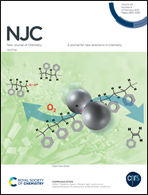Adsorption mechanism of NH3, NO, and O2 molecules over the FexOy/AC catalyst surface: a DFT-D3 study†
Abstract
Activated carbon-supported iron-based catalysts (FexOy/AC) show excellent deNOx efficiency. However, the specific adsorption mechanism of NH3, NO, and O2 molecules on their surfaces is still unknown. In this study, models of FexOy/AC were built and the adsorption mechanism of NH3, NO, and O2 molecules on their surfaces was investigated by a DFT-D3 study. FeO, Fe2O3, and Fe3O4 clusters can be stably adsorbed on the vacancy sites of the AC surface with charge redistribution. An NH3 molecule undergoes chemisorption to bind with the active Fe atoms of the FexOy/AC surface, which can form a coordinated NH3. The Fe2O3 cluster is the most beneficial to NH3 adsorption and results in the NH3–SCR deNOx reaction. When NO is adsorbed on the FexOy/AC surface, three kinds of adsorption products are obtained: nitrosyl (–NO), nitro (–NO2), and nitrite (–ONO) species. O2 can be adsorbed on the FexOy/AC surface to form adsorbed oxygen. The Fe3O4/AC surface has the most excellent adsorption property for NO and O2. NO can react with the adsorbed oxygen to form nitro, nitrite, and nitrate (–NO3) species. Moreover, the reaction paths and transition states of NH2 and NO2 formation were also investigated.



 Please wait while we load your content...
Please wait while we load your content...